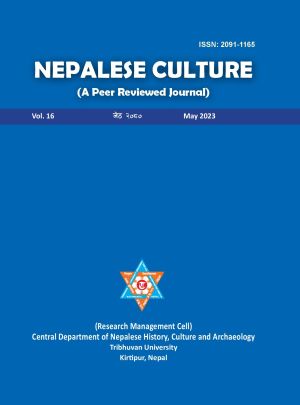नेपाली बौद्ध परम्परामा सोवारिग्पा पद्धतिको अवस्था {Position of Sowarigpa System in Nepalese Budhist Tradition}
DOI:
https://doi.org/10.3126/nc.v16i1.54164Keywords:
Sowarigpa, Amchi, medicine Buddha, herbsAbstract
बौद्ध समाज र संस्कृतिमा आप्mनै प्रकारको परम्परागत उपचार पद्धतिको विकास भएको छ, जुन पञ्चमहाविद्या अन्तर्गत पर्दछ । यस मतमा पञ्चमहाविद्या भित्र चिकित्सा विद्याका साथमा आध्यात्म विद्या, हेतु विद्या, शब्द विद्या र शिल्प विद्या पर्दछन् । बौद्ध परम्परामा चिकित्सा विद्याले मानिसलाई शारिरिक र मानशिक रुपमा निरोगी रहन मद्दत गरेको छ । यस विद्याको मूल ग्रन्थका रुपमा चार सुत्र रहेका छन्, जसलाई तिब्बती भाषामा घ्युसी भनिन्छ । यस पद्धतिमा रोग पत्ता लागेपछि तीन हजार मिटरभन्दा माथिल्लो भेगमा पाइने जडीबुटीको प्रयोग गरी औषधोपचार गर्ने चलन छ । सोवारिग्पामा जडीबुटी, खनिज र जनावरका अवशेषलाई औषधीका रुपमा प्रयोग गरिन्छ । यस पद्धतिबाट शारीरिक र मानसिक दुवै प्रकारको रोग निदान हुने मान्यता छ । सोवारिग्पा पद्धतिमा बिरामीका लक्षण हेर्ने र नाडी छामेर पनि रोग पत्ता लगाउने गरिन्छ । त्यसैगरी पिसावको रंग, फिँज र गन्ध हेरेर पनि बिरामीको अवस्था पत्ता लगाउने चलन छ । त्यस्तै बिरामीको जिब्रोबाट पनि रोग पत्ता लगाइन्छ । यस लेखमा नेपालमा सोवारिग्पा परम्परागत उपचार पद्धतिबाट शैक्षिक उपाधियुक्त ज्ञानका रुपमा परिणत हुँदै गएको अवस्थाकाबारेमा अध्ययन गरिएको छ ।
{Nepali Buddhist society and culture has developed its own type of traditional healing system, which falls under Panchamahavidya, literally speaking, five higher sciences. According to this view, five higher sciences includes spiritual science (aadhyatma-vidya), science of causes (hetu-vidya), science of words (grammar) (shabda-vidya), and architectural scince (shilpa-vidya), along with medical science (chikitsa-vidya).
In the Buddhist tradition, medical science has helped people to stay healthy physically and mentally. There are four sutras as the basic texts of Sowarigpa which are called Ghyusi in Tibetan langauge. In this method, after the diagnosis of the disease, it is customary to use herbs found above three thousand meters for the treatment. Herbs, minerals, and animal remains are used as the ingredients of medicine in Sowarigpa. The analyses of the healed people’s testimonies have showed that both physical and mental diseases can be diagnosed by applying sowarigpa method. In this method, patient’s symptoms are observed and the disease is diagnosed simply by holding the writs in a particular way. Similarly, it is customary in this traditional method to find out the condition of the patient by looking at the color, foam, and smell of urine. Moreover, the disease can be detected by simply observing the patient’s tongue. This article studies the situation where sowarigpa has been transformed from a traditional healing method into an academic knowledge in Nepali Buddhist tradition}.
Downloads
Downloads
Published
How to Cite
Issue
Section
License
© Central Department of Nepalese History, Culture and Archaeology, Tribhuvan University




